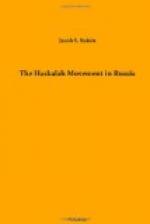On the struggle to retain the so-called Jewish mode of dress, see I.M. D(ick), Die Yiddishe Kleider Umwechslung, Vilna, 1844.]
[Footnote 20: Op. cit., pp. 12-13; cf. Letteris, in Moreh Nebuke ha-Zeman, Introduction, pp. xv-xvi; Bramson, op. cit., pp. 34-35, 43-44, and Levanda, Ocherki Proshlaho, St. Petersburg, 1876.]
[Footnote 21: Cf. Buckle, History of Civilization, New York, 1880, ii. 529-538.]
[Footnote 22: “Fifty years ago,” says Mr. Rubinow (Bulletin of the Bureau of Labor, no. 72, Washington, Sept., 1907, p. 578), “the educational standard of the [Russian] Jews was higher than that of the Russian people at large is at present.”]
[Footnote 23: Mandelkern, op. cit., iii. 33.]
[Footnote 24: Buckle, op. cit., pp. 140-142, notes 33-37.]
[Footnote 25: The same phenomenon was witnessed to a certain extent also in Galicia, where for a while Haskalah flourished in great splendor. There, too, the charm and fecundity of German literature, the similarity of Yiddish to German, and the privileges the Austrian Government accorded them, proved too strong a temptation for the Jews, and many of those who became enlightened were rapidly assimilated with their Gentile countrymen. While, therefore, in Galicia the Haskalah movement lasted longer than in Germany, it had ceased long before it reached its fullest development in Russia. Austrian civilization accelerated the assimilation of the educated, Polish prejudice retarded the progress of the masses. So that though Erter, Letteris, Krochmal, Goldenberg, Mieses, Rapoport, Perl, and Schorr exerted a great influence in Russia, their own country remained unaffected. Many of them, like A. Peretz, Eichenbaum, Feder, Pinsker, Werbel, and Rosenfeld emigrated to Russia, where they found a wider field for their activities, while others, like Professor Ludwig Gumplowicz, the sociologist, Marmorek, the physician, and Scheps, the litterateur, became alienated from their former coreligionists.]
[Footnote 26: Keneset Yisrael, iii. 84; Gottlober, Za’ar Ba’ale Hayyim, Zhitomir, 1868: [Hebrew: T’rng Nfshi ’lid Ki] (comp. Ps. xlii, and Shir ha-Kabod, last verse).]
[Footnote 27: Occident, v. 243. Cf. Buchholtz, op. cit., pp. 82-116.]
[Footnote 28: Occident, v. 255; Yevreyskaya Biblyotyeka, ii. 207-210.]
[Footnote 29: 1840, no. 9.]
[Footnote 30: Emden, Megillat Sefer, p. 5; Guenzburg, Debir, ii. 105-106; Mandelstamm, op. cit, i. 3-4, 11; Annalen, 1841, no. 31.]
[Footnote 31: FKN, pp. 246-247; Guenzburg, op. cit., i. 48. Moses Reines also points out the fact that the prominent rabbis did not withhold their approval of the most typical Haskalah works when their authors were not suspected of heresy, as shown by Abele’s haskamah on Levinsohn’s Te’udah be-Yisrael, Tiktin’s on Guenzburg’s Toledot ha-Arez, and Malbim’s on Zweifel’s Sanegor (Ozar ha-Sifrut, 1888, p. 61).]




